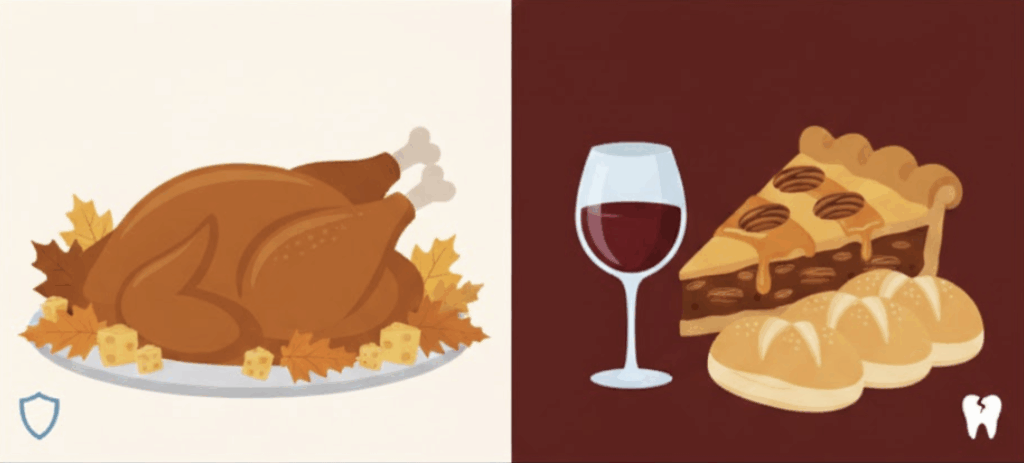Thanksgiving in Roseville is a time I cherish—a pause for gratitude, a chance to connect with family, and, of course, a day dedicated to a wonderful feast. As a dentist (and a fellow fan of Thanksgiving dinner), I know that this is a day for indulgence. But I also know that the traditional Thanksgiving menu, with its combination of sugars, starches, and acids, can create a perfect storm for your oral health.

Many of my patients at Designing Smiles ask me if they need to avoid their favorite foods. My answer is always "absolutely not!" The key isn't avoidance, it's awareness. Understanding what is happening in your mouth when you eat certain foods is the most powerful tool you have to protect your smile.
A single day of feasting won't ruin your teeth, especially if you have a strong daily hygiene routine. But this holiday provides a perfect opportunity to learn how our food choices impact our oral health, from our enamel and gums down to the microscopic bacteria that live in our mouths.
Think of this as your ultimate survival guide. We'll go on a deep dive into the science of the Thanksgiving "acid attack," explore the dental all-stars you should pile on your plate, identify the common culprits to be mindful of, and finish with a practical toolkit of pro-tips to keep your smile healthy and bright long after the leftovers are gone.
Before we can build our perfect plate, we need to understand what's happening on a microscopic level. Your mouth is a complex, dynamic ecosystem, and on Thanksgiving, it’s a battlefield. Here’s a breakdown of the key players and the main event.
The Cast of Characters:
The Main Event: The "Acid Attack" Your mouth has a natural pH balance, which is typically around 6.2 to 7.6 (neutral). However, when you eat sugary or starchy foods, the bacteria feast and produce acid. This causes the pH in your mouth to drop.
When the pH level drops below approximately 5.5—what we call the "critical pH"—your enamel starts to demineralize. This is a process where the acid literally leaches minerals from your teeth, weakening them and creating the microscopic soft spots that can eventually become cavities.
This "acid attack" begins within seconds of your first bite and can last for 20-30 minutes after you finish eating, until your saliva can neutralize the acid and bring your mouth back to a safe pH.
The Thanksgiving Challenge The problem with Thanksgiving isn't just one acid attack; it's a marathon of them. We graze. We snack on appetizers, have a huge meal, take a break, and then go back for pie, coffee, and wine. This means your mouth's pH may be stuck in the "danger zone" (below 5.5) for hours on end, not giving your saliva a chance to do its job and repair the damage.
Now that you're an expert in the science, you can see why our food choices matter. We want to choose foods that either don't fuel the bacteria or, even better, actively help our defenses.
A Note from Dr. Fung:
"As a dentist with a Mastership in the Academy of General Dentistry, I’ve dedicated my career to understanding the deep connection between oral health and overall wellness. Thanksgiving is the perfect example. The foods we eat don't just affect our teeth; they impact our gums, our digestion, and our whole body. My goal is never to take the joy out of food. It’s to empower you with knowledge so you can enjoy these wonderful holiday traditions while protecting your health for a lifetime. A healthy smile and a full plate can, and should, go hand-in-hand."
— Dr. Deborah Fung, D.D.S., M.A.G.D.
This is the good news! Many of the most iconic Thanksgiving foods are fantastic for your oral health. I group them into three categories: The Builders, The Scrubbers, and The Guardians.
1. The Enamel Builders (Foods rich in Calcium & Phosphorus) These are the building blocks of strong teeth. Calcium and phosphorus are the primary minerals that your enamel is made of, and they are essential for "remineralization"—the process of repairing the damage from acid attacks.
2. "Nature's Toothbrushes" (Fibrous & High-Water Foods) These foods work in two ways: mechanically and chemically. Their texture scrubs your teeth, while their high water content triggers saliva.
3. The Gum Guardians (Foods rich in Vitamins A & C) We often focus so much on teeth that we forget about their foundation: the gums! Healthy gums are crucial for a healthy mouth.
Again, no food is "forbidden." This is about managing how and when you eat these common holiday culprits to minimize their impact.
1. The Acid Attackers (Low pH Foods) These foods are damaging not because of sugar, but because they are already acidic. They drop your mouth's pH into the danger zone all on their own, softening enamel on contact.
2. Sticky Situations (High Sugar & "Cling Factor") The "cling factor" is a food's worst dental trait. The longer sugar sticks to your teeth, the longer the bacteria get to feed, and the longer the acid attack lasts.
3. Starchy Saboteurs (The "Hidden" Sugars) These foods might not taste sweet, but in your mouth, they become sugar almost instantly.
Here’s a simple visual guide to help you build your plate.
| Smile-Friendly All-Stars (Eat Freely) | On the "Watch List" (Enjoy in Moderation) |
|---|---|
| Turkey (Phosphorus) | Cranberry Sauce (Acidic, Sugary) |
| Cheese (Calcium, pH-Balancing) | Pecan Pie (Sticky, Sugary) |
| Crunchy Veggies (Fibrous, Cleansing) | Stuffing & Rolls (Starchy, "Hidden Sugar") |
| Nuts (Calcium, Stimulates Saliva) | Wine & Soda (Acidic, Staining) |
| Sweet Potatoes (Vitamin A) | Dried Fruit (Sticky Sugar) |
| Green Beans (Fibrous) | Caramel Drizzles (Sticky Sugar) |
You have the knowledge. Now, here is your actionable plan to enjoy the day, damage-free.
1. Hydrate Strategically with Water This is the most important tip. Don't just drink water when you're thirsty—drink it with your meal. Keep a glass of water on hand all day. Swish a gulp of water around your mouth after you eat your meal and especially after dessert. This physically rinses away food particles, dilutes the acids, and helps restore your mouth's pH.
2. Eat in One Go (If You Can) Remember the 20-30 minute acid attack? If you graze on appetizers for an hour, eat a meal, and then eat pie two hours later, you've subjected your teeth to three separate, long-lasting acid attacks. It is far better for your teeth to eat your main meal and dessert all in one sitting. This consolidates the acid attack into one manageable event that your saliva can handle.
3. The 30-Minute Rule (Wait to Brush!) This may be the most surprising tip. After you eat acidic foods (like cranberry sauce or wine), your enamel is in a temporarily softened, demineralized state. If you go to the bathroom to brush your teeth immediately, your abrasive toothpaste and brush can actually scrub away this softened layer of enamel, causing permanent damage. The Fix: Rinse your mouth thoroughly with water and wait at least 30-60 minutes. This gives your saliva time to neutralize the acids and begin the remineralization process. Then it is safe to brush.
4. Floss is Your Best Friend Thanksgiving is famous for getting food stuck in your teeth (looking at you, turkey and stuffing). Don't try to get it out with a fork, a fingernail, or a toothpick, which can damage your gums. Floss is the only tool for the job. That stringy piece of turkey stuck between your teeth isn't just annoying; it's a food source for bacteria. Flossing at the end of the day is non-negotiable.
5. Pack a "Go-Kit" If you're traveling to a relative's house, be prepared. Pack a small kit with a travel toothbrush, toothpaste, and a container of floss. Being able to give your teeth a proper cleaning at the end of the night, even if you're not at home, will make a huge difference.
Q: "What about pumpkin pie? Is it as bad as pecan pie?" A: This is a great question, and the answer is no, pumpkin pie is a much better choice! While it still contains sugar, its filling is soft, not sticky. It doesn't have the same "cling factor" as pecan pie or caramel. The pumpkin itself also provides that beneficial Vitamin A. If you want to make it even healthier, skip the (sugary) whipped cream. It's one of the most tooth-friendly dessert options on the table.
Q: "I love red wine at Thanksgiving. Is there anything I can do to prevent staining?" A: Yes! That "cheese board" tip is a great one. The protective film from the casein in cheese can help create a barrier. My best tip, however, is to drink water between sips of wine. Swish it around. This rinses the dark "tannins" (the staining compounds) off your teeth before they can settle in. And remember the 30-minute rule—don't brush right after your last glass.
Q: "What do I do if I crack a tooth on a nut or hard candy?" A: This is a dental emergency, but don't panic.
Q: "What if I'm at a relative's house and I can't brush my teeth for hours?" A: This is a common problem. The 30-minute rule still applies, but if you can't get to a brush, here are your best options, in order:
Q: "I love stuffing. Is it really that bad for my teeth?" A: It's not "bad" in the way poison is bad, but it is sneaky. The problem is the texture. It’s a soft, starchy food that your body turns into sugar. Because it's soft, it gets packed into the deep grooves of your molars. Think of it like a sticky sugar paste. My advice: enjoy your stuffing! Just be extra-thorough when you brush and floss that night to make sure you've removed all the residue from your chewing surfaces.
Thanksgiving is, and always should be, a day of gratitude and joy. By being mindful of how these delicious foods affect your oral health, you can enjoy the feast without a moment of worry. It's all about balance, awareness, and having a good plan.
From all of us at Designing Smiles in Roseville, we wish you and your family a very happy, healthy, and delicious Thanksgiving.
And remember, the best way to follow up your holiday feasting is with a professional cleaning and checkup. If you're due for a visit, or if you're looking to maximize your dental insurance benefits before the year ends, give our office a call. We are here to help you keep your smile bright all year long.
